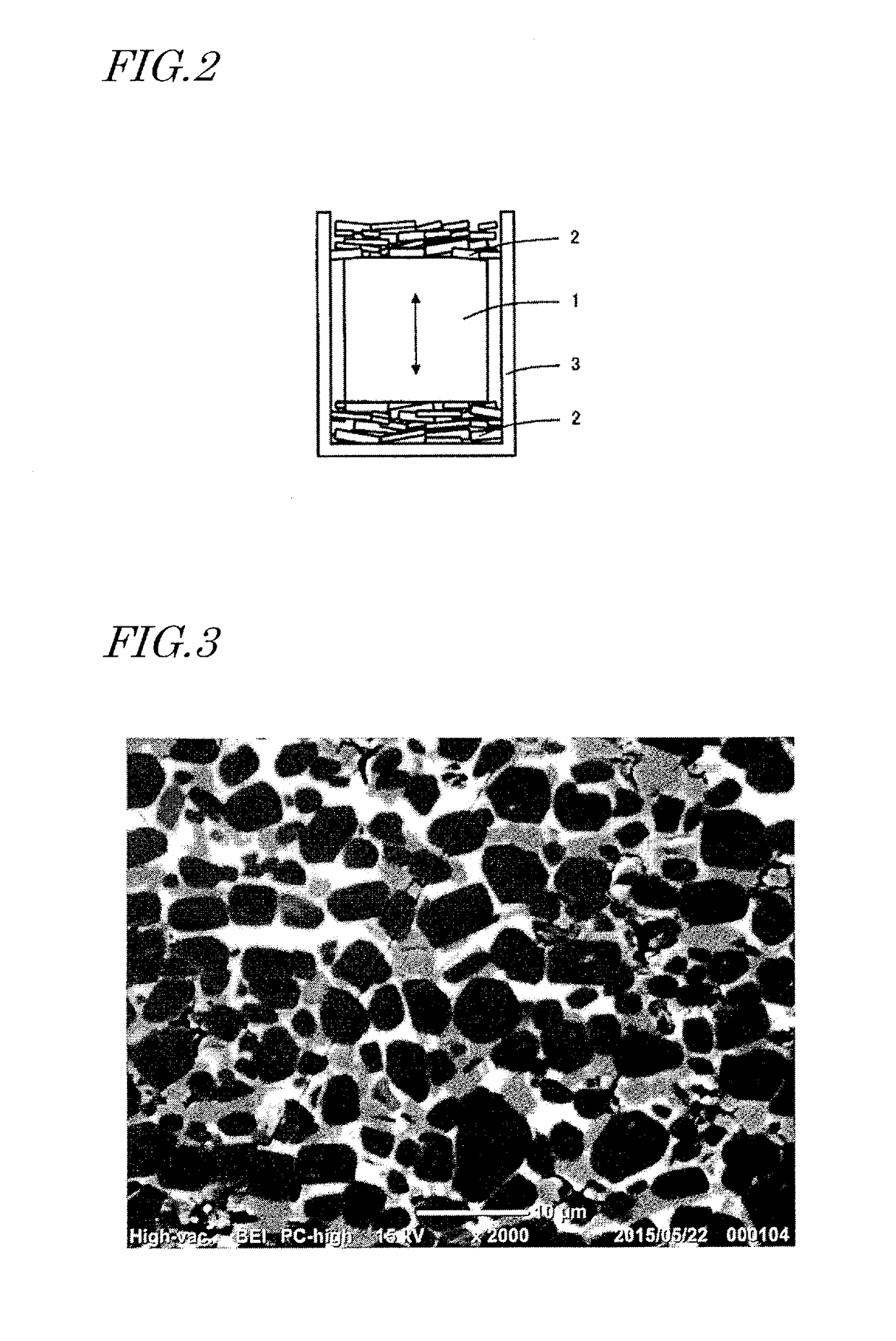Method for producing r-t-b system sintered magnet
a technology of sintered magnets and rtbs, applied in the direction of magnetic bodies, magnetic materials, transportation and packaging, etc., can solve the problems of rare earth elements, heavy rare earth elements, and inability to produce sintered magnets, and achieve high coercivity
- Summary
- Abstract
- Description
- Claims
- Application Information
AI Technical Summary
Benefits of technology
Problems solved by technology
Method used
Image
Examples
experimental example 1
[0083][Providing R1-T1-X Based Sintered Alloy Compact]
[0084]By using an Nd metal, a ferroboron alloy, a ferrocarbon alloy, and electrolytic iron (where each metal had a purity of 99% or more), the composition (without paying attention to Al, Si and Mn) of a sintered compact was adjusted to result in the compositions of Labels 1-A through 1-I shown in Table 1. These raw materials were melted and cast by a strip casting method, whereby raw material alloys in the form of flakes having a thickness of 0.2 to 0.4 mm were obtained. After each resultant raw material alloy in flake form was hydrogen-pulverized, it was subjected to a dehydrogenation treatment of heating to 550° C. in a vacuum and then cooling, whereby a coarse-pulverized powder was obtained. Next, to the resultant coarse-pulverized powder, zinc stearate was added as a lubricant in an amount of 0.04 mass % relative to 100 mass % of coarse-pulverized powder; after mixing, an airflow crusher (jet mill machine) was used to effect...
experimental example 2
[0095]A plurality of R1-T1-X based sintered alloy compacts were produced by a similar method to Experimental Example 1, except that the composition (without paying attention to Al, Si and Mn) of a sintered compact was adjusted to result in the composition of Label 2-A shown in Table 4.
TABLE 4R1-T1-X based sintered alloy compact composition (mass %)R1T1XR1[T1] / LabelNdPrFeAlSiMnBC(mass %)[X]2-A30.60.0667.30.050.040.030.870.0530.714.3
[0096]R2-Ga—Cu based alloys were produced by a similar method to Experimental Example 1, except for being adjusted so that the alloys had compositions Labels 2-a through 2-u shown in Table 5.
TABLE 5R2—Ga—Cu based alloy composition (mol %)R2[Cu] / LabelNdPrGaCu(mol %)([Ga] + [Cu])2-a010000100—2-b0971.51.5970.52-c0952.52.5950.52-d09055900.52-e0857.57.5850.52-f07512.512.5750.52-g0701515700.52-h0602020600.52-i0502525500.52-j0752507502-k07522.52.5750.12-l075205750.22-m07517.57.5750.32-n0757.517.5750.72-o075520750.82-p0752.522.5750.92-q0750257512-r18.7556.2512.512...
experimental example 3
[0098]An R1-T1-X based sintered alloy compact was produced by a similar method to Experimental Example 1, except that the composition (without paying attention to Al, Si and Mn) of a sintered compact was adjusted to result in the composition of Label 3-A shown in Table 7.
TABLE 7R1-T1-X based sintered alloy compact composition (mass %)R1T1XR1[T1] / LabelNdPrFeAlSiMnBC(mass %)[X]3-A30.60.0667.30.050.040.030.870.0530.714.3
[0099]An R2-Ga—Cu based alloy was produced by a similar method to Experimental Example 1 so that the alloy composition was the composition of Label 3-a shown in Table 8.
TABLE 8R2—Ga—Cu based alloy composition (mol %)R2[Cu] / LabelNdPrGaCu(mol %)([Ga] + [Cu])3-a07512.512.5750.5
[0100]After the R1-T1-X based sintered alloy compact was processed similarly to Experimental Example 1, the R2-Ga—Cu based alloy of Label 3-a and the R1-T1-X based sintered alloy compact of Label 3-A were placed so as to be in contact with each other in a manner similar to Experimental Example 1, and...
PUM
| Property | Measurement | Unit |
|---|---|---|
| temperature | aaaaa | aaaaa |
| temperature | aaaaa | aaaaa |
| size | aaaaa | aaaaa |
Abstract
Description
Claims
Application Information
 Login to View More
Login to View More - R&D
- Intellectual Property
- Life Sciences
- Materials
- Tech Scout
- Unparalleled Data Quality
- Higher Quality Content
- 60% Fewer Hallucinations
Browse by: Latest US Patents, China's latest patents, Technical Efficacy Thesaurus, Application Domain, Technology Topic, Popular Technical Reports.
© 2025 PatSnap. All rights reserved.Legal|Privacy policy|Modern Slavery Act Transparency Statement|Sitemap|About US| Contact US: help@patsnap.com



